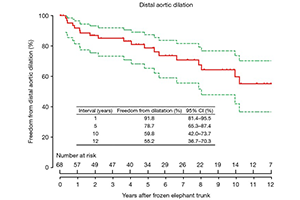Is the frozen elephant trunk technique justified for chronic type A aortic dissection in Marfan syndrome?
Abstract
Background: Chronic type A aortic dissection (cTAAD) in Marfan syndrome (MFS) is rare. Surgical experience is limited and the role of frozen elephant trunk (FET) technique remains undefined. We seek to evaluate the safety and efficacy of the total arch replacement (TAR) and FET technique for cTAAD in MFS.
Methods: The clinical data of sixty-eight patients with MFS undergoing FET and TAR for cTAAD were analyzed.
Results: Mean age was 35.8±9.7 years and thirty-nine were male (57.4%). Operative mortality was 10.3% (7/68). Stroke occurred in one (1.5%), re-exploration for bleeding in five (7.3%), low cardiac output in four (5.9%), and acute renal failure in two (2.9%). Follow-up was complete in 100% (61/61) at mean 7.3±4.0 years. The false lumen was obliterated in 73.5% across FET and 50.0% in unstented descending aorta (DAo). Distal dilation occurred in twenty patients, six of whom underwent thoracoabdominal aortic replacement, one abdominal aortic replacement and one thoracic endovascular aortic repair (TEVAR). Late death occurred in five. At ten years, 59.8% were free from distal aortic dilation, and the incidences were 23.2% for death, 14.4% for distal reoperation, and 62.4% for reoperation-free survival. Predictors for operative mortality were extra-anatomic bypass [odds ratio (OR), 229.592; P=0.036], preoperative maximal size (DMax) of aortic sinuses (mm) (OR, 1.134; P=0.032) and cardiopulmonary bypass (CPB) time (minute) (OR, 1.061; P=0.041). Risk factors for aortic dilatation included patent false lumen at diaphragmatic hiatus [hazard ratio (HR), 5.374; P=0.008], preoperative DMax (mm) of proximal DAo (HR, 1.068; P=0.001) and renal arteries (HR, 1.102; P=0.005) which also predicted distal reoperation (HR, 1.149; P=0.001). The time from onset to operation (day) (HR, 1.002; P=0.004) and CPB time (minute) (HR, 1.032; P=0.036) predicted late death.
Conclusions: This study shows that the TAR and FET technique is a safe and durable approach to cTAAD in patients with MFS. The operation should be performed as early as possible to optimize clinical outcomes.
Cover






